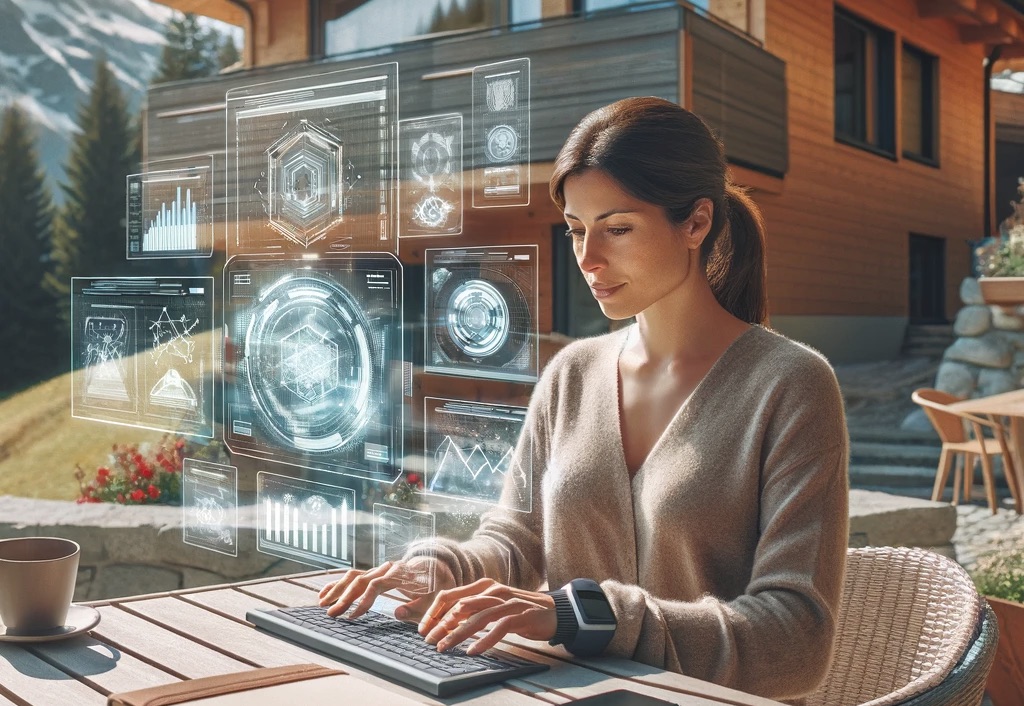It’s important to skate to where the puck is going. As the year draws to a close, I wanted to go through the exercise of jotting down my predictions for next year. This way, I can look back in approximately 12 months time and see how I fare.
Initially, I didn’t intend for this list to be so AI-centric. Part of this direction reflects the stagnation of other areas in technology. I don’t have too much to say about the Apple Vision Pro or AR as of yet so I’m going to adopt a “wait and see” approach. The other reason is AI’s undeniable significance. The more I engage here, the more enthralled I become, even if I am joining the bandwagon 5 years too late.

Working over the holidays, anatomy of a fall style. DALL-E prompt: Generate an image of a woman working with hologram computers on the outdoors of a holiday chalet
Without further ado, here goes:
1. AI models: Multimodal, Layered, and Smaller
Large Language Models (LLMs) will evolve into model graphs and stacks. We are already seeing this with GPT-4 and its competition, and this trend is likely to gain momentum. Although these models will continue to appear as a unified interface, they will be composed of multiple, smaller models working collaboratively. That way, model developers can keep their models smaller, tighter and cheaper to run while add capabilities by adding new models into the mix. I predict that in 2024 we will see an acceleration of work on integrating with the larger web. Users will see exponential benefits with modest amount of model improvements patched together by increasingly complex engineering.
2. The First Signs of AI as a Disruptive Force Emerges
Ben Thompson suggests that AI is more of a sustaining technology. While it’s true that it feels like big tech has the momentum in AI tech, it feels like there is a break through that has yet to happen. AI’s non-linear nature poses an existential threat to software-assisted workflows. As the technology matures and scales, I expect to see new products take shots at existing business models that will catch the incumbents off guard.
3. New UI Paradigms Will Emerge for AI
Chat interfaces, like ChatGPT, are not the best. They feel like stopgap and the decade long experiments done by Alexa and other voice in a tube systems exposes the downsides. Despite the linguistic basis of LLMs, we will see a gradual movement away from these UIs as people experiment and build with them. As an analogy, the shift here will be akin to the move from command-line interfaces to graphical user interfaces. My guess is that a new modality (such as Augmented Reality headsets, Humane Pin, etc.) will gain traction and we will be talking about it by the end of the year.
4. AirPods Will Become Apple’s Most Important Product
Apple will integrate a “cutting edge” AI agent into their AirPods, and the device + service will become their inaugural AI consumer product offering. The distribution and pervasiveness of AirPods will put this quasi-AR quasi-AI service into the hands of millions of people. However, the extent to which Apple may restrict integrations could seriously stunt its potential. We shall see.
5. Google Will Face Competitive Pressure; SEO Market Reshapes
Given the increased popularity of ChatGPT-like services and the prevalence of SEO spam that is clogging up search results, Google will face its Alta Vista moment with Search. This combined with the AI use in SEO and content industry wide could dramatically reshape, or even decimate, the SEO industry.
6. Design Remains Stubbornly Attached to the Past, New Shoots Sprout.
To date, the Design industry response to AI has been mostly superficial. While many will continue to cling to our existing practices, a vocal minority will emerge to pioneer new ways of working with and designing for stochastic systems. Whether these concepts can take hold will be crucial for our industry’s relevance in the coming era.